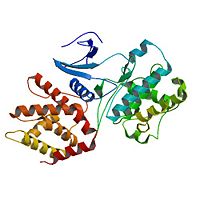Sandbox 210
From Proteopedia
Contents |
CDK5-p25 complex
CDK means Cyclin Dependent Kinase. The cyclin-dependent kinases (CDKs) are a large family of serine–threonine kinases which control the eukaryotic cell cycle, when they are activated by the cyclin regulatory subunit. These kinases phosphorylate a very large number of protein in order to inactivate or activate them.[1]
Cyclin dependent kinase 5(CDK5) is a unique member of CDK family members that is not activated by a cyclin. Instead it is activated by a kinase, p35 also named Cyclin-dependent kinase 5 activator. Unlike other CDKs, it plays a major role in cell communication, cell morphology and motility.
CDK5 could form a complex with p25, an other protein.
Discovery of CDK5
Reported by four independent groups of scientists in 1992, Cdk5 had multiple names. A first group reported it as a neuronal Cdc2 like kinase (NCLK) characterized and cloned from rat brain c-DNA library as a Cdk that phosphorylates the lysine–serine–proline motif of neurofilaments. It was reported to have 58% amino acid sequence homology with mouse Cdk1 and 61% homology with human Cdk2. While looking for several Cdks, which play an important role in eukaryotic cell cycle, a second group found Cdk5/PSSALARE kinase (with an alpha C helix) among several other Cdks. A third group of scientists called the same molecule as brain proline-directed protein kinase (BPDK), reporting it in bovine brain with functional similarity to cdc2. In the same year, the fourth group named it as Tau protein kinase II (TPK II) associated with microtubules. Later in 1993, the nomenclature settled down to Cdk5 after identifying the 30 kDa protein subunit of the active enzyme.[2]
Structure
The subunit of the CDK5 shares also a very similar three-dimensional (3D) structure with CDK2.
Sequence similarities
The of the CDK5-p25 complex share homologuous sequences with the cell division protein kinase 5 and the with the cyclin-dependent kinase 5 activator (p35).
Applications of CDK5-p25 complex
Biology
CDK5-p25 complex Control
References
- ↑ Zhang B, Su ZC, Tay TE, Tan VB. Mechanism of CDK5 activation revealed by steered molecular dynamics simulations and energy calculations. J Mol Model. 2010 Jun;16(6):1159-68. Epub 2009 Dec 15. PMID:20013135 doi:10.1007/s00894-009-0629-4
- ↑ Dhariwala FA, Rajadhyaksha MS. An unusual member of the Cdk family: Cdk5. Cell Mol Neurobiol. 2008 May;28(3):351-69. Epub 2008 Jan 8. PMID:18183483 doi:10.1007/s10571-007-9242-1


